Chapter 1 - Information Systems in Global Business Today
in Notes / Othermajors / Managementinformationsystems
3/13 ~ 15
- 1: The Role of Information Systems in Business Today
- 2: Perspectives on Information Systems
- 3: Contemporary Approaches to Information Systems
1: The Role of Information Systems in Business Today
How Information Systems are Transforming Business
- IT investment now takes a big part in total investment
What’s New in MIS
- continual change in technology
- successful firms = firmst that leran how to use new technologies
- big data
- cloud computing..etc
Globalization Challenges and Opportunities: A Flattened World
- Globalization (세계화)는 어느곳에서든 Localization (현지화)가 가능해야 한다
- 세계의 구조: (사회) 정보를 보유한 자가 지위를 차지
Flattening of the world society \(\Rightarrow\) achieved and accelerated by IT (정보기술)
- 본인의 지식이 더 이상 자산이 아닌, IT가 모두에게 제공한다
- \(\Rightarrow\) 권력의 이동
This \(globalization\) presents both challenges and opportunities for business firms
- 바야흐르 global 시대
- 과연 좋은 것일까? 미국의 경우 (2011) 국내보다 인건비가 싼 국외로 옮겨 시민들은 타격을 봄
- still, outsourcing has actually accelerated the development of new systems in the US and worldwide
The Emerging Digital Firm
- Digital 기업이란?
- 정보통신 기술을 하나도 쓰지 않는 것 (전화, 신용카드 … etc)
- 기업 내 (소비자, 공급자, 직원) 들이 디지털로 연결되고 디지털로 관리되는 것
Strategic Business Objectives of IS (Information Systems)
- 현대 사회에서는 디지털이 필수적이며, 모든 분야에서 디지털이 포함된다
- 모든 기업은 다 디지털 기업이다 (아닌거 찾기가 더 어려움)
- 어떠한 디지털 기술들이 (IT트레드를 살펴보며) 이로운지 탐구하는 것이 중요
- 책의 제목: Management Information Systems: Managing the
Digital Firm
- Operational Excellence:
자동화 (속도) New Products, Services, and Business Models:
신규 비즈니스 모델 만들때 도움됨- Customer and Supplier Intimacy:
- 소비자와 Supplier의
needs를 정확하게 파악 하고 해결 \(\rightarrow\) 매출도 UP - 소비자 데이터 collect 가능 \(\rightarrow\) 만족도 향상을 위해 (알고리즘)노력 가능
- 처음 보는 고객에게 Hit Rate 높이기 (by using similar user’s data) \(\rightarrow\) Loyalty
- \(\Rightarrow\) INTIMACY
- 소비자와 Supplier의
- Improved Decision Making
- 인력 자원,
실시간 데이터 로 성공확률 높이기
- 인력 자원,
- Competitive Advantage (경쟁 우위 확보)
- 실상 이기기 위한이 아닌, 최소한의 baseline을 두기 위해.
-
경쟁의 기회 를 얻기 위해 (뒤쳐지지 않게)
-
Survival : 경쟁에서 살아님기 (5의 연장)
2: Perspectives on Information Systems
IT (정보기술) Infrastructure: 조직의 목표를 달성하기 위한 하드웨어 + 소프트웨어의 집합
What is an Information System?
- subset of IT
set of interrelated components that (아래 4가지 기능을 하는 것)
- collect (모으기), retrieve (꺼내오기 (이미 있는 데이터를))
- process (처리 및 가공)
- store (저장)
- distribute (제공, 공유)
- 역할
- 시스템이란: Input \(\rightarrow\) processor \(\rightarrow\) output \(\rightarrow\) feedback \(\rightarrow\) input
- closed vs open system: 위 프로세스 중 외부와 교류 가능한지 -
open system: preferable
Visualization of Information System
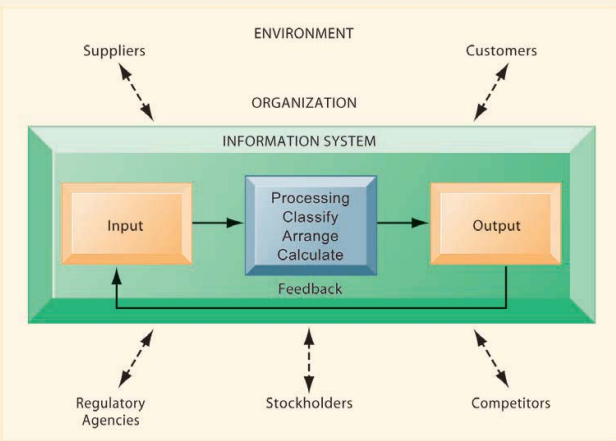
Information Hierarchy?
- 정보의 계층도
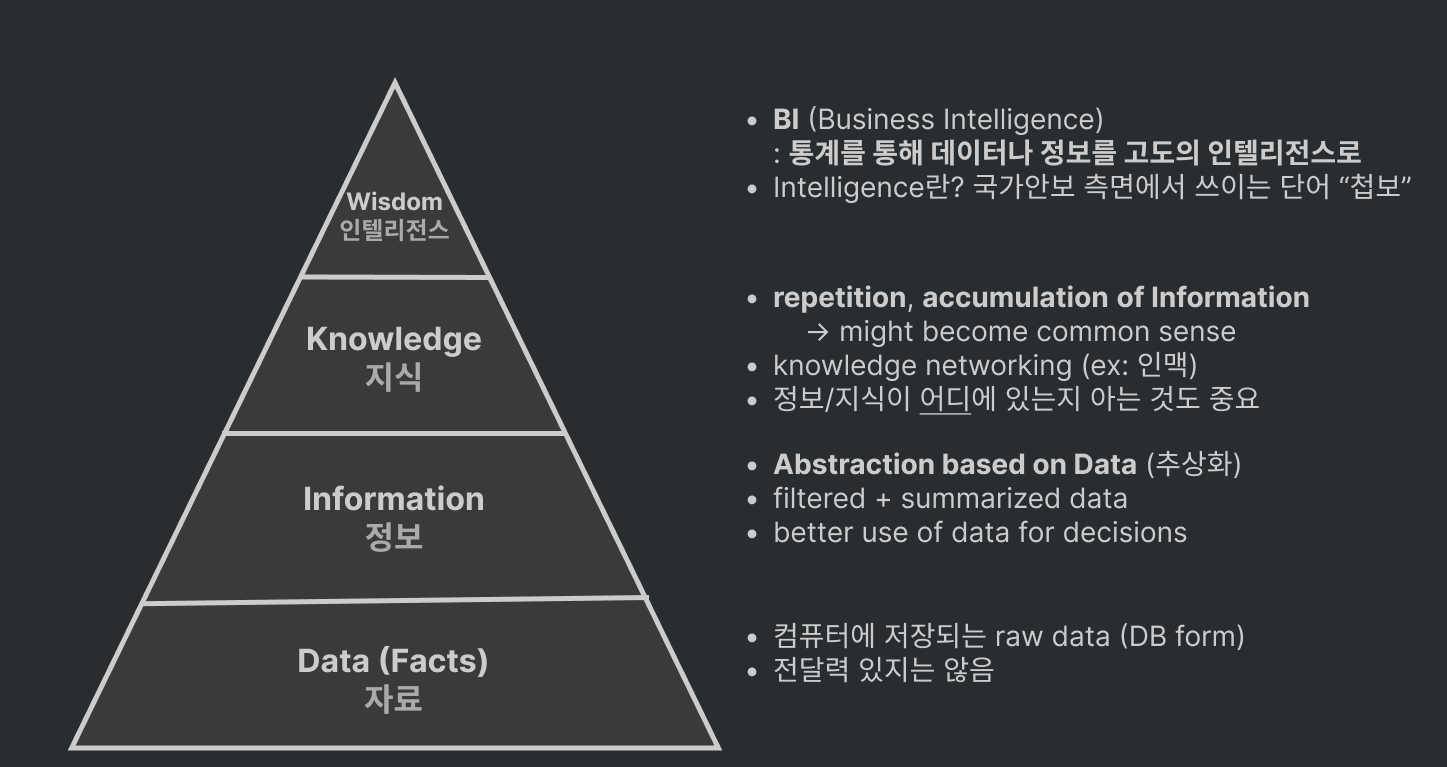
Dimensions of IS
- IS Literacy: broader understanding of IS \(\Rightarrow\) What MIS tries to achieve
- Computer Literacy: focuses primarily on knowledge of IT
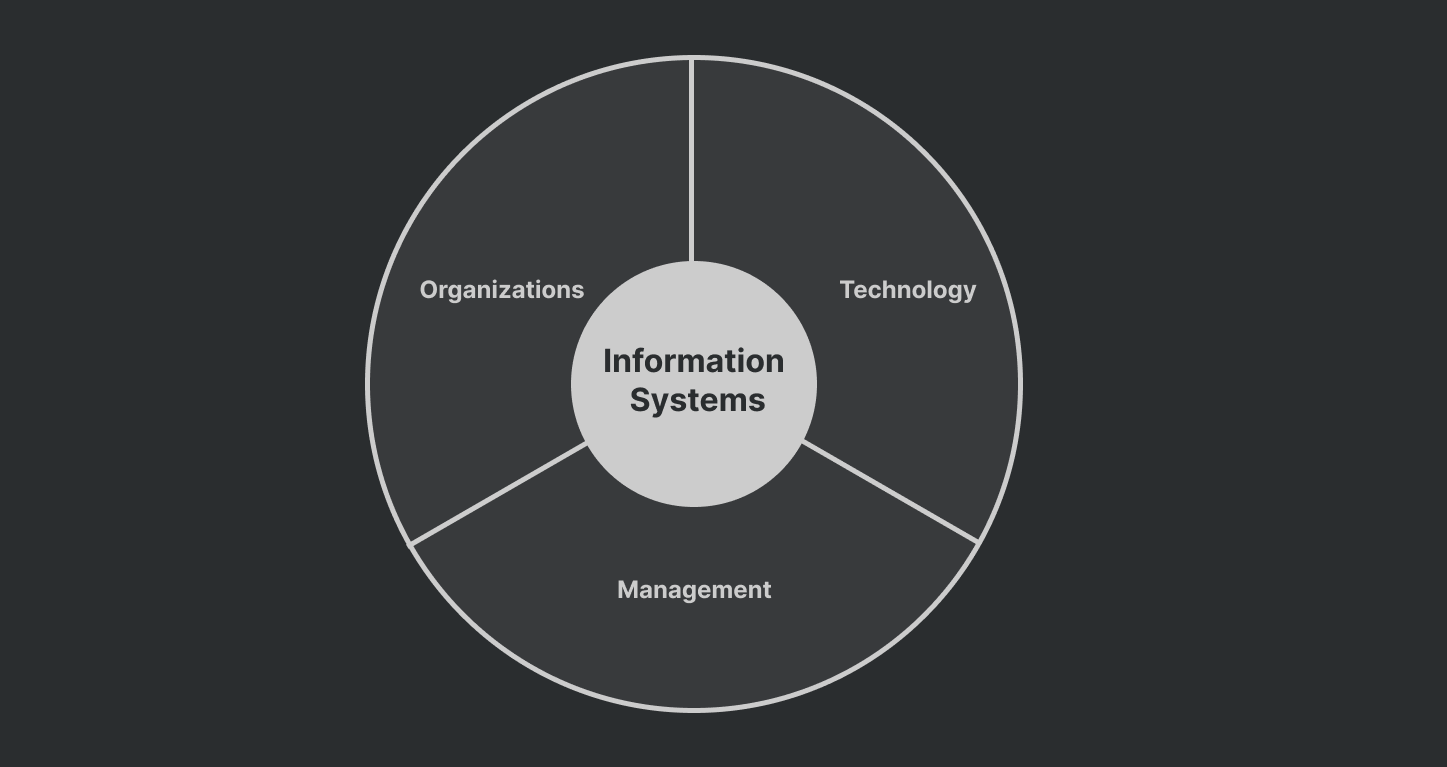
-
경영의 목표 (또는 경영자의) - Peter Drucker (경영학의 대부)
- 효과성 (effectiveness) \(\Rightarrow\) 리더
- 효율성 (efficiency) \(\Rightarrow\) 관리자
Organizations
-
조직 = 일 + 사람 사람:
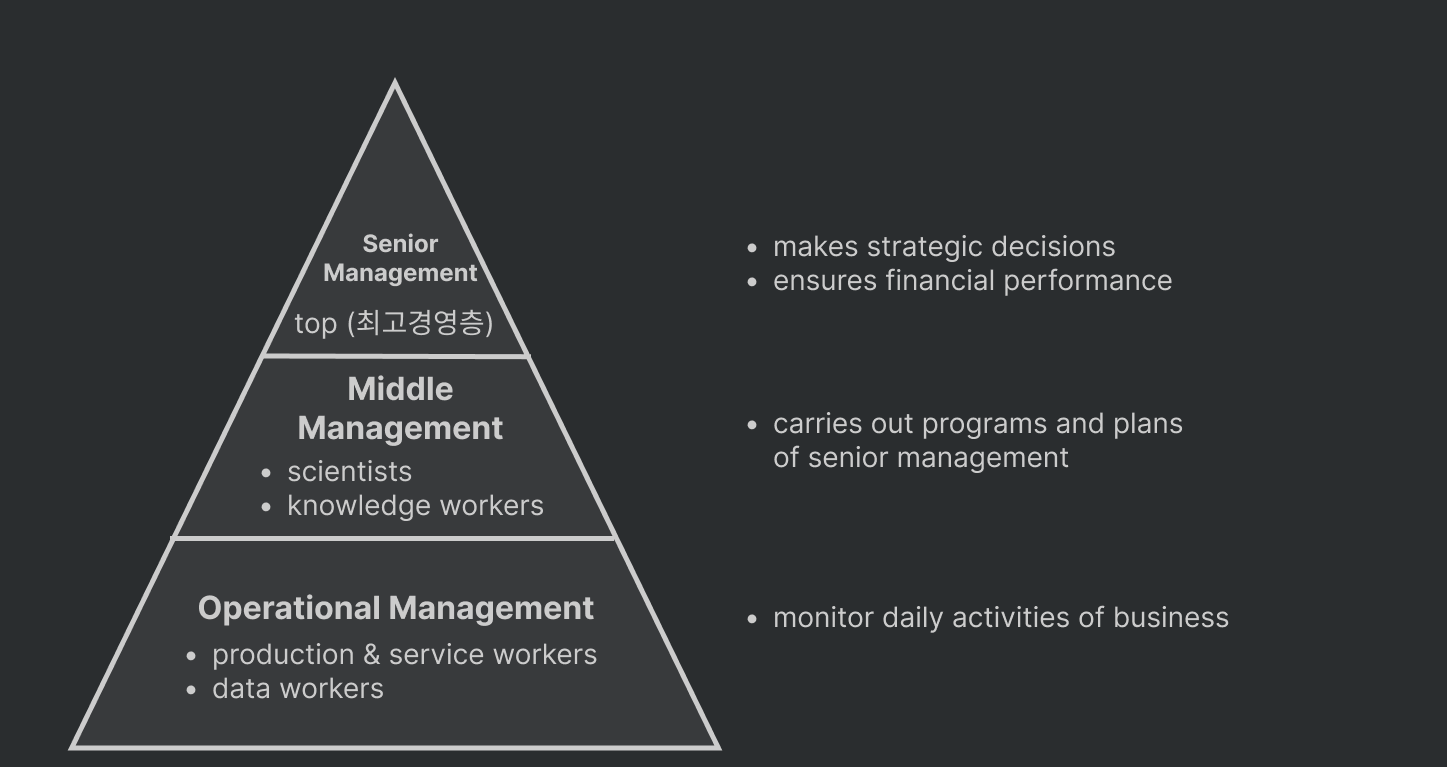
일: Function (직능, 기능) \(\rightarrow\) Department (부서)
Function (most common) Purpose Sales and marketing Selling organization’s products & services Manufacturing and production producing & delivering products & services Finance and accounting Managing financial assets + maintaining financial records Human resources Attracting, developing, maintaining labor force..etc
Management
- face and solve organizational problems
- make decisions + formulate action plans
- must exercise responsible leadership
- manage more than what already exists
Information Technology
- Computer related, to be discussed further in Chapter 5
3: Contemporary Approaches to Information Systems
- IS 는 multidisciplinary field이다. (no single theory or perspective dominates)
Technical, Behavioral Approach
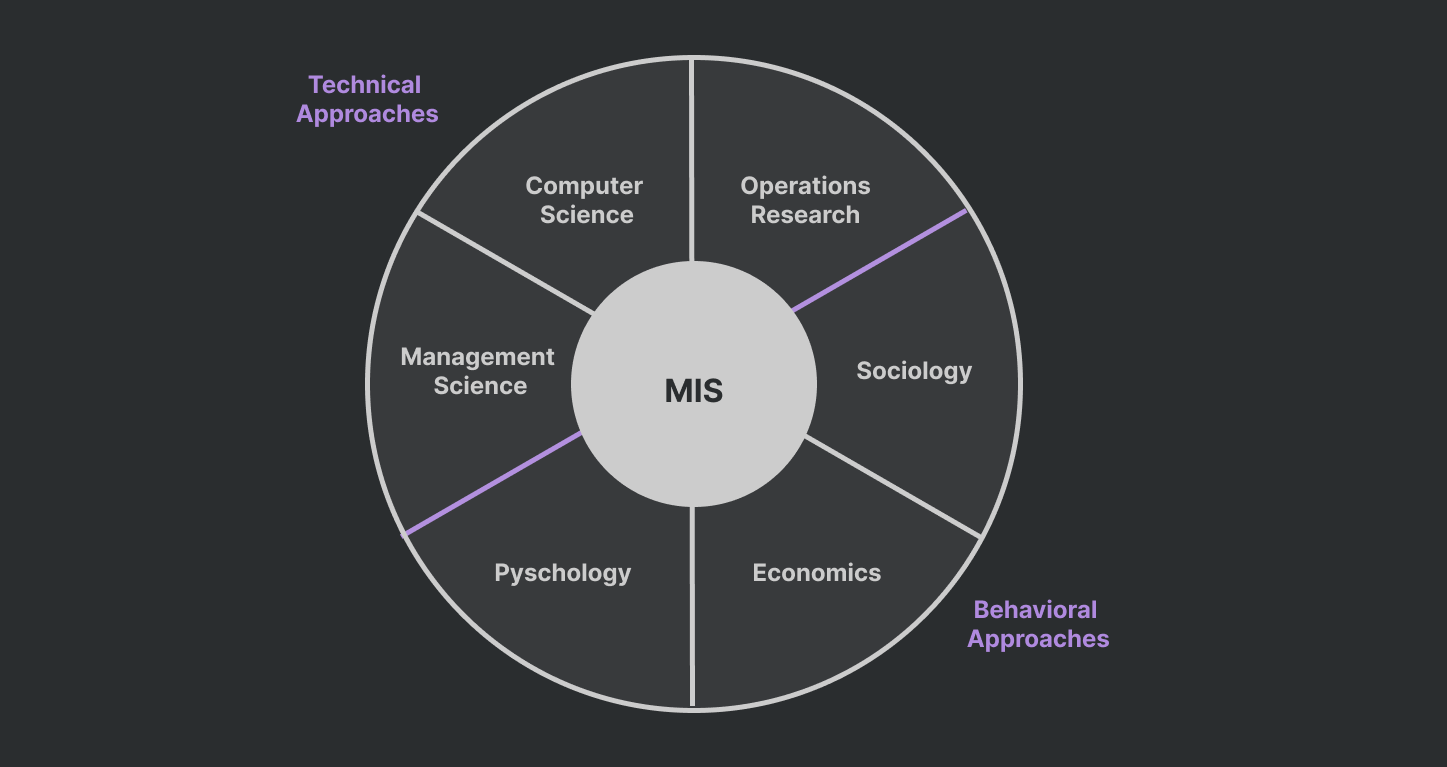
| Technical Approach | Behavioral Approach |
|---|---|
| mathemtatical models, physical tech / formal capabilities of systems | strategic business integration, design, implementation, utilization, management |
Approach of this Text: Sociotechnical Systems
-
Sociotechnical view of systems (adopted in this book)
- \(social\) + \(technical\) systems = optimal organizational performance achieved
- Review Questions
